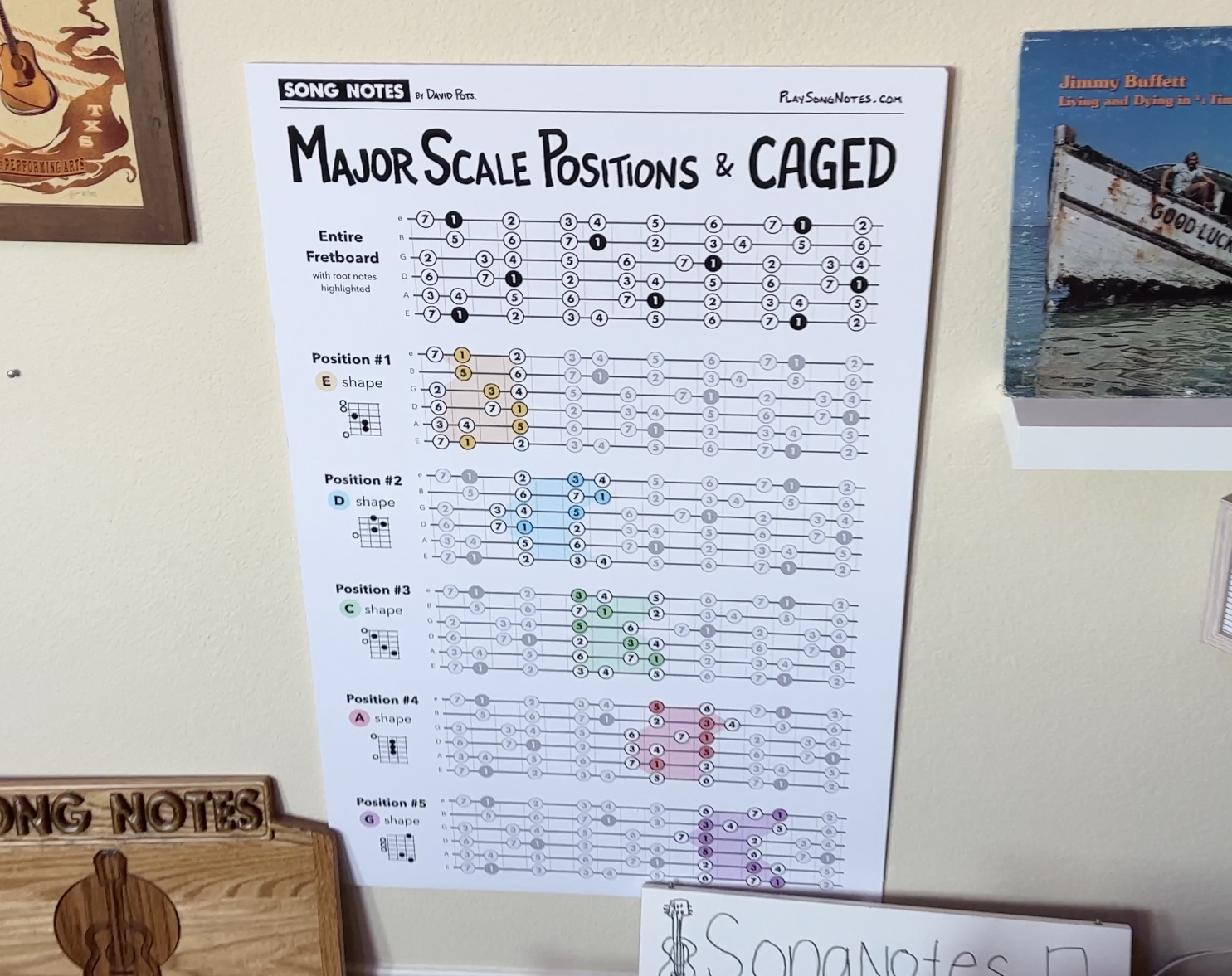Hey there, friends! Quick lesson today where I want to show off what’s been the most helpful practice tool for me in the past couple years, especially as I’ve gotten a bit further into lead guitar playing. It’s a fretboard map showing the pattern of notes that make up the major scale – and highlights the “CAGED” shapes you can find within this pattern.
For me, the poster is the most helpful when I’m noodling around and settle into a certain riff or phrase. If I’m unsure which scale position this riff is based, the poster jumps immediately to aid. I’ll simply look use a target note I’m playing (usually the root or “1”) — and then find its match on the poster. Once spotted, this shows me the surrounding notes I’m able to use — as well as the surrounding major scale patterns. From there, it makes any further riffing much easier since I know where I am & what’s around me.
In this lesson I’ll show you a few simple ways I might use this poster. One is a straightforward major scale exercise, where I’ll pick any note on the fretboard and see how I might build a complete major scale either going up or down the neck. Then I’ll show a few common nursery rhyme melodies, and walk through how I use the poster for guidance as I practice playing them. Let’s get into it!
Here’s a few playthrough videos, with tabs on screen, showing some of the specific melodies I reference in my main lesson. For each melody below, I’ll start on a random note — and then show two ways to play the complete melody, using CAGED shapes that connect to the starting note. Tabs for everything below are also available in my instructional PDF (available above).
Played using the “A” and “C” scale shapes. Both start on the 8th fret of the fifth string.
Played using the “G” and “A” scale shapes. Both start on the 7th fret of the third string.
Played using the “E” and “D” scale shapes. Both start on the 7th fret of the fourth string.
If you want your own copy of the PDF I used to make the poster shown in my video, it’s all yours! Get the PDF for lesson #384 - and see page 7. That’s what I took to Office Depot and had blown up to a large size, before putting it on my wall. While digital stuff is helpful, I’m a huge fan of a dedicated print-out that’s on the wall and readily viewable.

Start here if you’re looking for first steps with the CAGED system! This is must-know if you want to venture beyond the first few frets of the guitar. I give a slow explanation of how the notes on the fretboard repeat in a predictable pattern – no matter which key you’re in! The pattern is based on the open chord shapes C, A, G, E, and D you already know— which is where we get the “CAGED” name. Learn the pattern once, apply it anywhere. View lesson details and PDF »
CAGED is helpful for far more than just chord shapes. You can also use each shape to play the major scale. This video teaches you the five shapes, walking you through each scale. View lesson details and PDF »
Looking for a simpler place to get started with the major scale? Start here! I teach the five most common major scales (keys of C, G, D, A and E) in the first few frets of the guitar. Beyond practice exercises, knowing scales can be incredibly helpful for working out song melodies, finding flourish notes to add to open chords, and more. View lesson details and PDF »
On this website I have an interactive fretboard tool (Fret Monster) which is a great way to play around & connect the dots with all this CAGED stuff. The tool lets you select a key, a scale, and how you want each note on the fretboard labeled (note names, scale degrees, etc). Play around with it! I bet it will help a lot of these concepts make more sense.